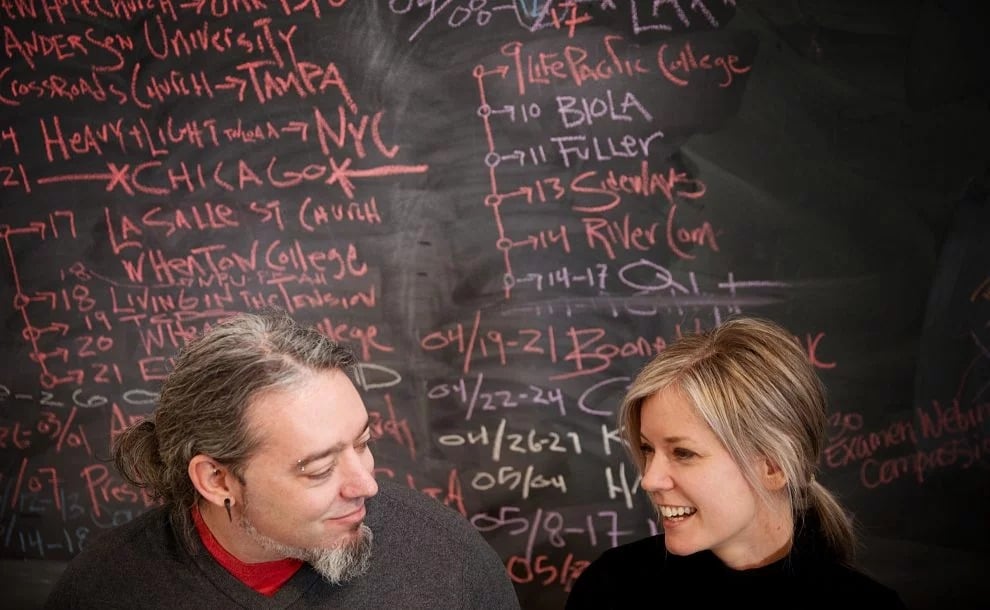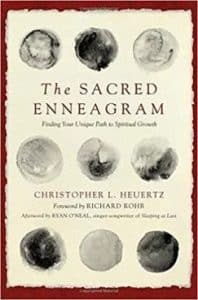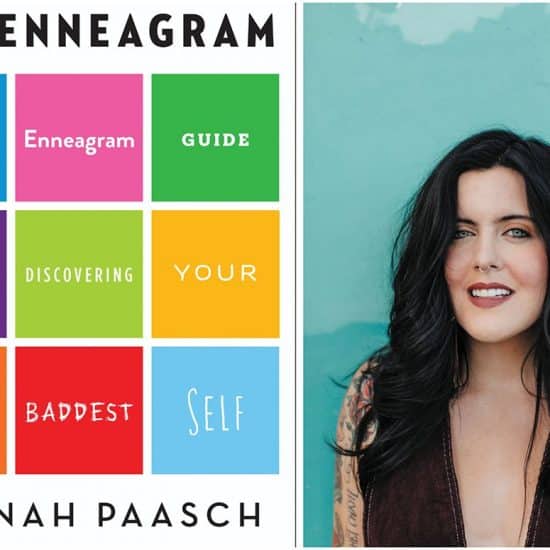

Chris (left) and Phileena Heuertz co-founded the Gravity Center in Omaha. Chris’s latest book is “The Sacred Enneagram.” (BRYNN ANDERSON/THE WORLD-HERALD – Used by permission of Chris Heuertz)
A personality typing system has been quietly infiltrating Christian communities for the last quarter-century. But some believers may be excused for their skepticism.
After all, the “Enneagram” is an ancient system of unknown origin with a strange name. It is replete with sacred language, but is not explicitly Christian in orientation. It centers on nine personality types that are arranged into a chart resembling a pentagram. Yet, it is spreading like wildfire among a diverse range of Jesus-followers.
In 1990, Franciscan Fr. Richard Rohr effectively Christianized the system for Americans when he published “The Enneagram: A Christian Perspective” in English. This sparked a growing interest that slowly crept into church pulpits and small groups. In 2016, Christianity Today published “An Evangelical’s Guide to the Enneagram” after Intervarsity Press became the first evangelical publisher to release a book on the topic.
To understand why the Enneagram is so alluring, I sat down with Chris Heuertz, author of “The Sacred Enneagram: Finding Your Unique Path to Spiritual Growth.” Heuertz is the co-founder of The Gravity Center and has been mentored by sages such as Rohr and Mother Teresa. He conducts Enneagram workshops around the world and is something of an Enneagram master, though I imagine he would resist such a label. Here, we discuss why the Enneagram is captivating so many Christians and how he responds to its critics.
RNS: Let’s start with the basics. What is the Enneagram?
CH: The Enneagram illustrates the nine archetypal human character structures, the nine beautifully flawed ways of being us.

Image courtesy of Zondervan
RNS: Beautifully flawed?
CH: Yes. The Enneagram shows us our ego’s set of coping addictions that we’ve wrapped up around a childhood wound so that we don’t have to be truthful about the pain it’s caused us. Until we’re honest about this, we lie to ourselves and others about who we really are.
The Enneagram’s nine types form a sort of color wheel that describes the basic archetypes of humanity’s tragic flaws, sin tendencies, primary fears, and unconscious needs. As a sacred map to our soul, the Enneagram is a blueprint for developing character that each of us carries throughout our life, but one that we don’t open until we discover our type.
RNS: So this is an ancient personality typing system, right? Where did it originate?
CH: There are rumors of the Enneagram showing up more than 6,000 years ago in ancient Egypt and more than 4,000 years ago in pre-historic Korea. Folk Buddhism may have version of the Enneagram. Many Catholic and Protestant scholars claim it was developed by the early church’s desert mothers and fathers. And the Sufis of Central Asia also lay claims to its origins. We do know that in the 1950s and ’60s the Bolivian wisdom teacher Oscar Ichazo brought forward the Enneagram of Personality, which is what we commonly use today.
Even if it’s a system with thousands of years of hidden history yet only 60 to 70 years of application in its modern form, it’s an exciting time to explore the possibilities of what is still to be uncovered. It’s not an understatement to suggest that we hardly understand what it is we are working with.
RNS: Let’s dig in. Explain the nine personality types of the Enneagram.
CH: I first learned the Enneagram by aligning a distinguishing need with each of the numbers. These needs emerged from the evolution of Father Richard Rohr’s early, yet groundbreaking work, on the Enneagram. Here’s a chart to explain:
| Type One | The Need to Be Perfect |
| Type Two | The Need to Be Needed |
| Type Three | The Need to Succeed |
| Type Four | The Need to Be Special (or Unique) |
| Type Five | The Need to Perceive (or Understand) |
| Type Six | The Need to Be Sure/Certain |
| Type Seven | The Need to Avoid Pain |
| Type Eight | The Need to Be Against |
| Type Nine | The Need to Avoid |
The Enneagram offers nine mirrors for self-reflection. These nine mirrors, if we choose to gaze into them directly, can help us shake loose of our illusions that end up getting us lost from home in the first place.
The Enneagram teaches us nine approaches to observing the patterns of human character structure archetypes. These patterns fortify a kind of psycho-spiritual-somatic muscle memory that shapes how we think, feel, and act.
I often introduce the Enneagram’s nine types through what motivates them. They are laid out in this chart:
| Type One strives for principled excellence as moral duty. |
| Type Two strives for lavish love through self-sacrifice. |
| Type Three strives for appreciative recognition from curated successes. |
| Type Four strives for the discovery of identity for faithful authenticity. |
| Type Five strives for decisive clarity through thoughtful conclusions. |
| Types Six strives for steady constancy from confident loyalty. |
| Type Seven strives for imaginative freedom for inspirational independence. |
| Type Eight strives for impassioned intensity for unfettered autonomy. |
| Type Nine strives for harmonious peacefulness as congruent repose. |
RNS: This isn’t just another personality typing system like Meyers-Briggs or something. You believe the Enneagram is “sacred,” right?
CH: One of my teachers, Russ Hudson says, “Type isn’t a ‘type’ of person, but a path to God.” I believe it’s sacred because as a map of our soul it’s a compassionate sketch of possibilities. The Enneagram is less about nine “types of people” and more about nine paths back to our true selves and nine paths to divine love.
If we can’t self-observe, then we can’t self correct. The Sacred Enneagram helps us self observe, helps us tell the truth about who we really are coming clean from our delusions and illusions, so that we can locate the authentic source of our identity.
RNS: How does one align one’s Enneagram type with specific types of prayer?
CH: In The Sacred Enneagram, I suggest that contemplative prayer practices are framed by three primary postures: solitude, silence, and stillness. I present nine unique contemplative prayer postures and prayer intentions combinations that I think perfectly align with each of the nine Enneagram types as these distinct paths to God.
RNS: The whole system seems weird and mystical. Why are so many Christians, even those in flyover states, being drawn to the Enneagram?
CH: Because the truth of the Enneagram–that each and every one of us is beautiful and beloved by God–resonates with all of us. We also know the Enneagram’s tragic truth that many of us don’t live into the gifts and grace of that truth.
Many people allow fragments of their identity to lay claim to the whole of who they think they are. This only leads to an addictive loop of our mental and emotional preoccupations. This is how we get ourselves lost. The challenge is to find our way home.
The Enneagram helps us begin an honest interrogation of the depths of our identity, of who we really are. When we accept our inherent beauty, we find the courage to examine what makes us beautiful—to honestly encounter both the good and the bad, the shadow and the light. More than anything I’ve encountered, the Enneagram helps us do just that. A lot of other people, including Christians, are discovering this too.
RNS: Ok. But even many conservative evangelical Christians are attracted to it. Why?
CH: I sort of wonder if the evolved evangelical is getting a little worn out from the same old literal Bible study interpretations of stuff. At least Catholicism can appeal to tradition and saints. I wonder if some evangelicals have gotten bored with what their tradition offers, and therefore, they find a deeper and more contemplative system like the Enneagram appealing.
RNS: You acknowledge that other religions, such as Buddhism and Sufism, have utilized this system. What do you say to a Christian who says this is a non-Christian or even pagan system that should not be trusted?
CH: Certainly anyone rooted in a community of faith has to appeal to their notion of truth as the landing place for where they rest their beliefs. But we know that truth isn’t confined to any one tradition. It’s not a scandal to affirm that divine love reaches towards all of us, wherever we are, and regardless of our response to it.
My sense is that if other communities of faith outside the one you locate yourself in can access something that is true, it doesn’t necessarily mean you can’t trust it. Rather, it means you need to learn to trust yourself and your own ability to discern how to relate to truth. And that’s exactly what the Enneagram offers—the tools and keys to grow in discernment as you learn to trust yourself and receive divine love.


